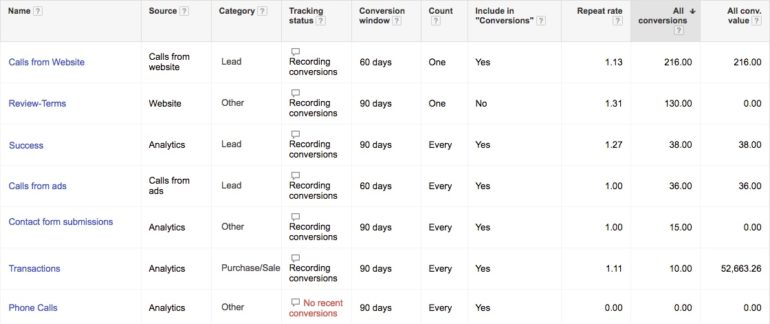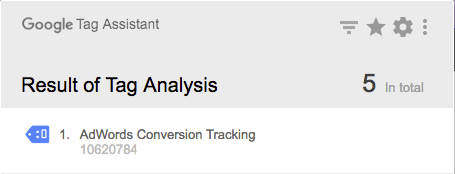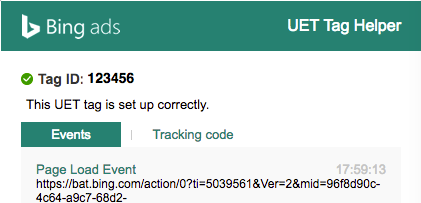Conversion tracking plays such an important role in measuring the success of paid search performance. However, how many times do you revisit the goals and check the tracking? Most of the time, you should only have to setup conversion tracking once and you can forget about it. Or can you? It may be a good idea to go back on occasion and double check the tracking.
Audit Your Conversion Actions
In AdWords, it’s a good idea to conduct a full audit of all your conversion actions. Do you have AdWords conversion tracking setup or are the goals imported from Analytics? Are all the goals valid and are they valuable conversions? Do you have a conversion in your account that is not a true conversion? Is an important action missing or is a goal being tracked twice?

One of my clients was tracking actions that they felt were important. In this case, it was to review the terms before completing the checkout. However, this did not mean customers submitted payments. Realizing that this action wasn’t generating revenue, we decided to not count this action as a conversion. We wanted to make sure we were optimizing our account for the most valuable actions.
Phone Call Tracking
Considering the shift in mobile traffic and how much it is on the rise, many customers may prefer to call a business while on their mobile device to ask a question. Are you missing out on counting phone calls as conversions? This may not be an action you feel is important, but it is helpful to know how many website calls resulted from PPC ads. This is the conversion action that I find many people are not thinking about. Sometimes we find that phone calls make up 20-40% of our total conversions.
For example, some of my clients are not using 3rd-party call tracking and they aren’t using AdWords dynamic call tracking either. Mobile traffic continues to increase, are phone calls increasing too? Some of our accounts that added Google call tracking found their leads increased up to 30%. This was especially true for higher priced items and customers may have felt more comfortable talking to a person to place the order.
Some clients would prefer to only track leads or ecommerce conversions. Let’s say you have a keyword that generates a higher volume of phone calls, but you are not tracking phone calls. This keyword may have a higher CPL/CPA and the data might lead us to decrease bids or pause a good keyword. Next thing you know, your phone calls start to decline and we are missing the data we need to figure out why.
Double Tracking Or Missing Conversions
There have been situations where the client has conversion tracking installed on the website and the same goal is being imported from Analytics. Sometimes the goals have very different names, making it difficult to spot. It may be a good idea to update the naming convention so it is clear to anyone who reviews the account what goals are being tracked.
Are you missing conversion goals? There have been occasions where the client had two different websites and only one website was pulling in goals. We have found this scenario happens frequently when there is a separate mobile-specific website. If you look under “Tools > Webpages” you can easily see if you are missing a domain.
Conversion Tracking Fails
Over the years, I have lost track of how many times a website conversion tracking stopped working. Websites that have multiple conversion goals setup can really make it difficult to spot when one stops working. A decrease in conversion volume week-over-week is expected, but once you have two or three weeks in a row where the conversions haven’t rebounded, you need to start digging.
On one occasion, I remember checking performance and we had 529 conversions that reported overnight. This sudden spike in traffic was unexpected and we quickly discovered the conversion tracking code had been placed on every page on the website. This one day created a mess in our reporting for quite a while. It was a good thing we could notify the client and they corrected it quickly.

Partial Conversion Decline
In the past, I have spent hours sifting through the data trying to figure out if a keyword stopped converting or if our average position dropped. There are so many valid reasons why your performance can fluctuate, something simple as seasonal fluctuations. It could be something as simple as you updated all your text ads.
However, after enough times of the conversion tracking breaking, that is often one of the first things I check. Sometimes clients make a change in the website and the codes get dropped during the update. We have also had times where the code was replaced improperly causing it to fire intermittently. Sometimes, an entirely new website is launched and advertisers are not alerted.
Spot Check The Tracking
When you are managing websites, it’s a good idea to keep track of the URLs so you can spot check them on occasion. I typically use Chrome and I add the Google Tag Assistant and Bing UET Tag Helper extensions. These tools can help me easily spot an error with the tracking codes. You can enter the thank you page URL and quickly check that tracking is in place and without errors.


Final Thoughts
Hopefully, this post will help you make sure your conversion tracking is setup and working as it should. We all get busy and it can be easy to overlook something that shouldn’t have an issue. However, better to find it sooner rather than later.




